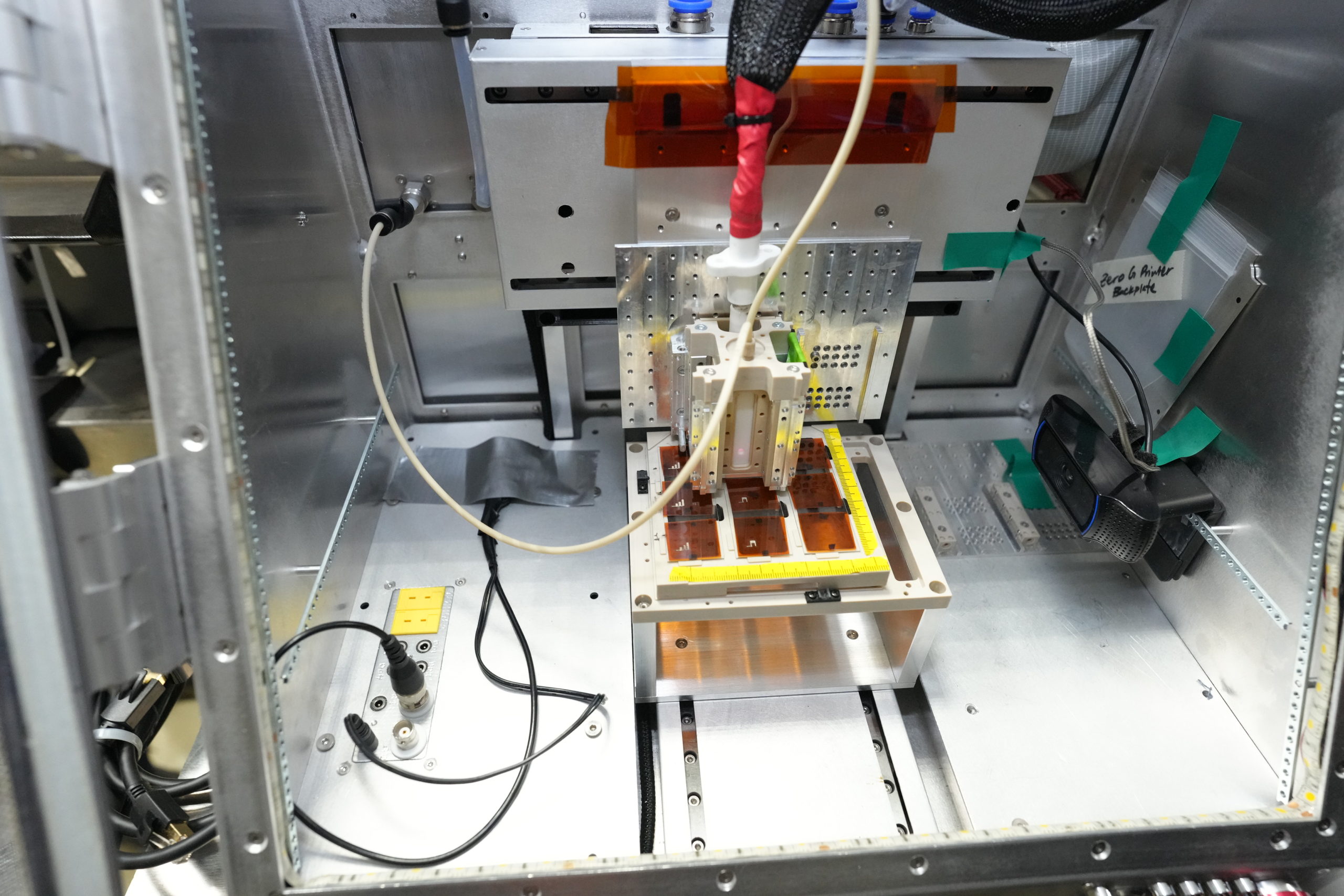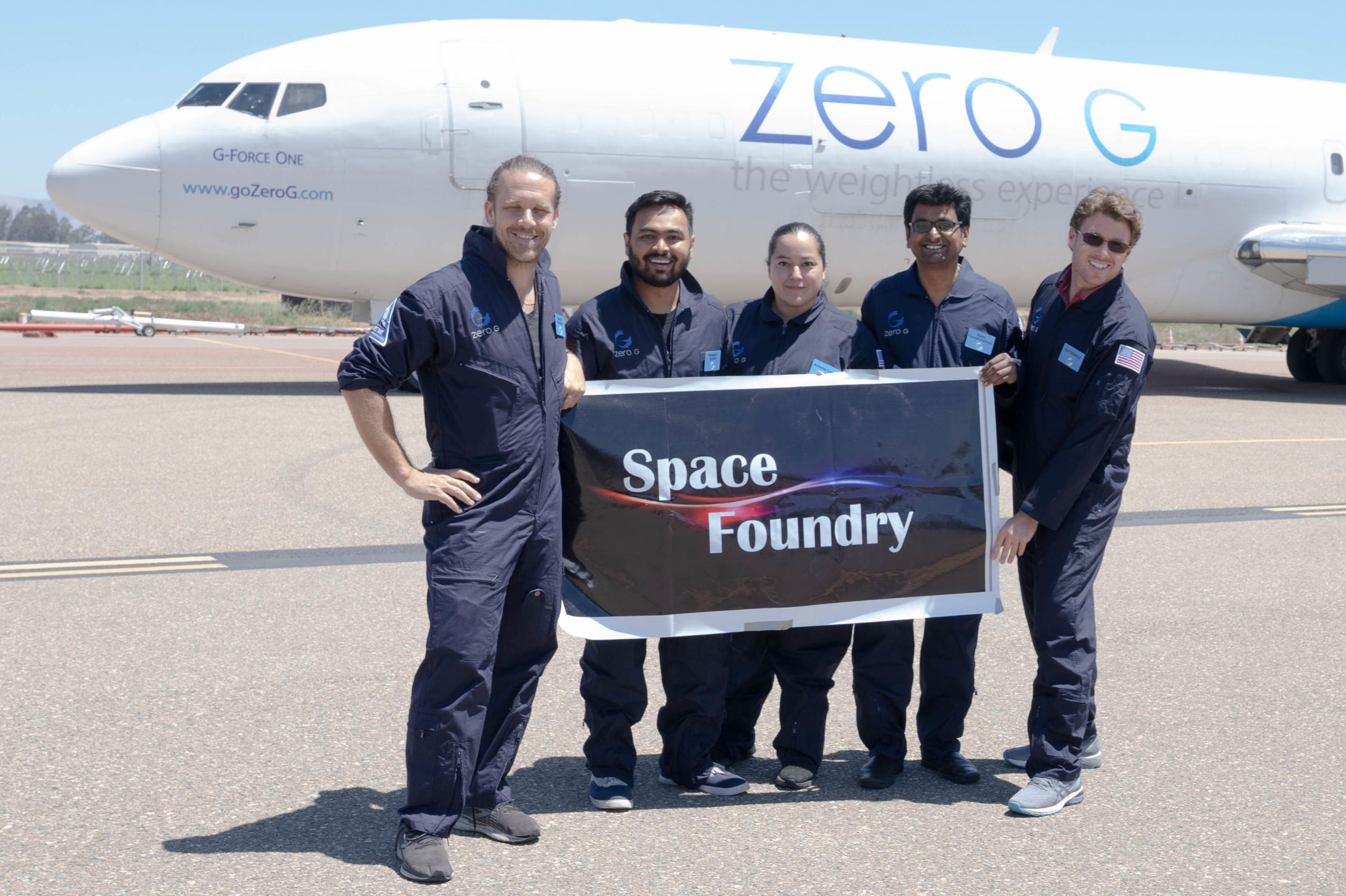A spinoff company out of NASA Ames Research Center (ARC) in California has created a plasma-based 3D printing process for electronics using a single-step approach that doesn’t require heat or ultraviolet curing, as other methods do. Launched in 2016 by former NASA researcher Ram Prasad Gandhiraman and Stanford University’s SLAC National Accelerator Lab scientist Dennis Nordlund, Space Foundry is banking on its technology to disrupt the printed electronics industry and become an essential resource for the future of space 3D printing and off-Earth exploration.
Space Foundry has developed the hardware, software, and process for printing electronic materials, like copper, without curing. With the potential to overcome issues associated with ink and post-processing, its technology has received several NASA grants, including Phase I and II Small Business Innovation Research (Small Business Innovation Research), further to develop it for in-space manufacturing and in-situ resource utilization. Working towards that goal, the team has tested its plasma jet printer in parabolic flights, which simulate microgravity.
Following a successful demonstration in December 2021 aboard the G-Force One converted Boeing 727, operated by Zero Gravity Corporation, the team printed silver lines, pads, interdigitated electrodes, and a Wi-Fi-antenna using a plasma jet printer – the company had a second flight. On June 28, 2022, Space Foundry successfully printed silver and copper for on-demand electronics manufacturing. To learn about the technology behind Space Foundry and its future strategies for product commercialization, 3DPrint.com talked to CEO and founder Gandhiraman.
The Space Foundry plasma printer is a multilateral printing platform that can print various materials, including metals, dielectrics, organics, and even bioinks. Plasma jet printing technology is based on the interaction between aerosolized ink and plasma. By carefully controlling the plasma process, the electronic structure of the ink materials can be tailored, and the oxidation state of the metals can be precisely controlled. This technology is poised to enhance NASA’s in-space manufacturing efforts through On-Demand Manufacturing of Electronics (ODME), part of the Game Changing Development Program, as plasma jet printing can potentially be used in the future low Earth orbit (LEO) and for manufacturing on the lunar surface.
Described by Gandhiraman as a highly miniaturized version of semiconductor manufacturing technology, Space Foundry’s 3D printing system uses a print head to discharge plasma to control the electronic structure of printed materials. In summarizing, the robust plasma jet print head and the process can reliably and reproducibly print conducting metal films with a tailored oxidation state and electronic structure.
“Controlling the flow in microgravity is very challenging. So we are using an electromagnetic field, a high voltage source, to generate the plasma and control the fluid flow independently of gravity. Thereby, we have this very controlled plasma that can control the fluid flow, which is why NASA is interested in our technology,” highlighted Gandhiraman.
When it comes to space, the smaller, the better. As we have covered in many past stories, both space agencies and private space companies are aiming to create products and technology that fit into small compact spaces, not just for easy handling but also because heavy and expensive payloads are just not viable for future long-duration missions. Indeed, putting a pound of payload in LEO used to cost roughly $10,000 in 2016. Today, that cost has gone down. For example, SpaceX charges approximately $3,000 per pound of payload aboard its Falcon 9 workhorse rocket. So again, the aim is to create technologies that can offer the same process as traditionally big machines but in a smaller package.
Eliminating steps from a process or technique is another aim for space missions. Generally, for printed electronics, there must be at least three different equipment for pre-processing, printing, and post-processing or curing. Space Foundry eliminates these complexities since its technology is a “one-step process” that lets users print electronics without worrying about cleaning or post-processing.
In microgravity, we succeed
During the last microgravity test, Gandhiraman said the team tested the plasma jet printer and patent-protected plasma print head, just like last time, except now they were also testing a copper ink developed in-house that can survive for a longer time without any shelf-life issues. Gandhiraman says that for NASA, something like this would be critical since the agency can send small cartridges of the “ink” and use it to print on demand without displaying any storage issues or complications. The team demonstrated printing on June 27 and 28, 2022, which means it is one step closer to launching its 3D printer to the International Space Station (ISS) for more testing.
“Our goal is to have a demonstration of the printed electronics system on the ISS within the next two years. So far, we have worked with NASA and multiple funding agencies to get the system up there as quickly as possible. I can say that for now, all proposals have been submitted, and although we don’t have any news yet about a potential date, the plan is still to get this technology to the ISS,” revealed the CEO.
Space Foundry aims to become a household name for materials processing in space. Gandhiraman imagines a bright future for his technology at the ISS and upcoming projects with private companies working on their commercial space platforms, and printed electronics will be a big part of it all. Without electronics or connecting materials, devices won’t function, he states.
However, Gandhiraman says that space business takes time and revenue generation is not easy, which is why Space Foundry is also looking for electronics applications on Earth. The startup has been selling equipment primarily to universities and R&D labs. This helped them throughout the early stages of development. Today, Space Foundry believes its technology is a gamechanger for aerospace and defense customers interested in direct-write printing on complex non-planar objects for aircraft and missiles.
Since the company also created a modular print head that can be installed to compliment other machines and 3D printers, Gandhiraman believes that reaching out to 3D printer manufacturers will be the next step in their commercialization strategy. Its modular print head has already been tested for integration into a robotic arm built by NextFlex, America’s Flexible Hybrid Electronics (FHE) Manufacturing Institute. NextFlex is also building an additional large area manufacturing platform which will also have Space Foundry’s integrated modular print head.
With the global market for printed electronics equipment roughly around $8 billion in 2021, it is easy to imagine that Space Foundry’s technology could succeed, and has the potential to reduce dependence on high-quality inks, eliminates process steps (curing of inks in particular), and expands the portfolio of materials that can be used for embedded printing as well as printed on existing structures. Not to mention the potential of this technology in space manufacturing, one of the harshest environments known to humans, where the dependence on new platforms and systems will be a decisive factor for mission success.
Subscribe to Our Email Newsletter
Stay up-to-date on all the latest news from the 3D printing industry and receive information and offers from third party vendors.
You May Also Like
3D Printing Financials: Fathom Struggles in Financial Quicksand During Critical Transition
Facing a year of key transitions and financial pressures, Fathom (Nasdaq: FTHM) has filed its annual report for 2023 with the U.S. Securities and Exchange Commission (SEC). The document outlines...
Latest Earnings Overview for Australian 3D Printing Firms Titomic and AML3D
Australian 3D printing manufacturing firms Titomic (ASX: TTT) and AML3D (ASX: AL3) reported their financial results for the period from July to December 2023, marking the first half of their...
3D Printing Webinar and Event Roundup: April 7, 2024
Webinars and events in the 3D printing industry are picking back up this week! Sea-Air-Space is coming to Maryland, and SAE International is sponsoring a 3D Systems webinar about 3D...
3D Printing Financials: Unpacking Farsoon and BLT’s 2023 Performance
In the Chinese 3D printing industry, two companies, Farsoon (SHA: 688433) and Bright Laser Technologies, or BLT (SHA: 688333), have recently unveiled their full-year earnings for 2023. Farsoon reported increases...



































